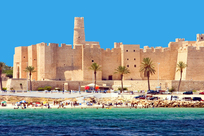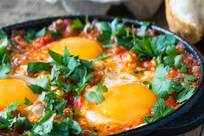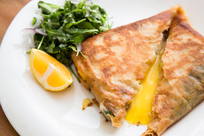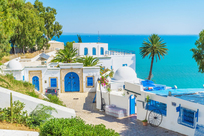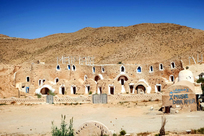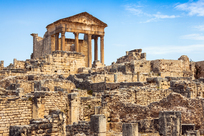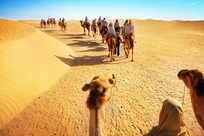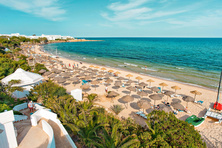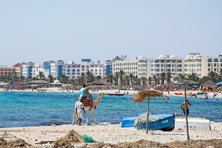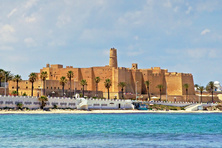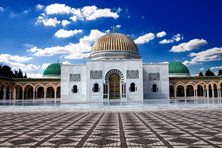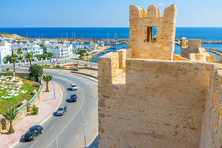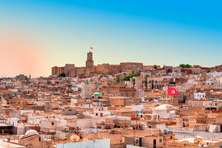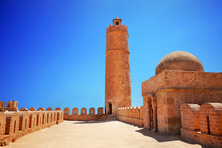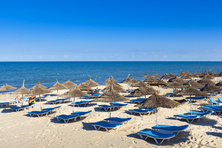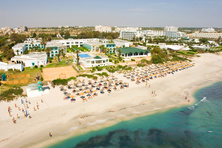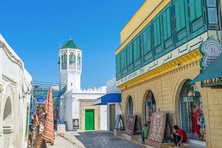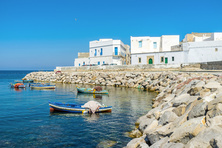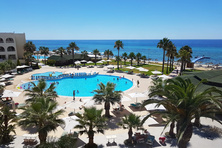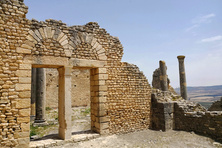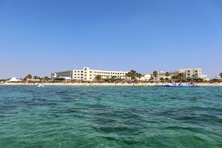Tunisia
- Capital:Tunis
- Currency: Tunisian dinar
- Time: UTC+1
- Languages: Arabic
- Religions: Islam (Sunni)
- Sections: Get in Visa Customs Cuisine Money Details of interest Popular resorts
The Tunisian Republic is a country in North Africa on the coast of the Mediterranean Sea. It borders Libya and Algeria. The capital city is Tunisia.
The climate in Tunisia is Mediterranean subtropical on the coast and tropical on the south. On the coast, the average winter temperature is +10°C and in summer, the temperature is +26°C. On the south, the average temperature is +21°C and in summer, it is +33°C. The lovers of beach holidays should come to Tunisia from September to November and from March to June. The best time for excursions and for getting acquainted with the history and culture of the country is winter. Winter is also perfect for undergoing a thalassotherapy treatment.
The official languages are Arabic and French. In touristic areas, people can also speak English and German. In the mountains, the locals speak Berber dialects.
The majority of the population in Tunisia are the Sunni Muslims (95%). There are also some Christians and the followers of Judaism.
Tunisia attracts the tourists with its sandy beaches. The best beaches are located in Mahdia, Sousse, and Hammamet. Good places for diving are Tabarka, Bizerte, and Djerba Island.
The lovers of shopping should go to Nabeul.
Tunisia is famous for its historical and cultural centres with many sights. Visit Tunisia, Shemtov, Dougga, El Kef, Kairouan, and Monastir. You will see unique landscapes in Douz, Matmata, and Sfax.
Many tourists choose Tunisia because of thalassotherapy as there are a lot of well-being programs. The main spa centres are located in Hammamet, Sousse, Monastir, Mahdia, and Djerba.
Get in
By Plane
Nouvelair and Tunisair offer direct flights to Tunisia from Moscow, Saint Petersburg, Kiev, Kharkov, and Minsk. The flight time is 4 hours.
Alitalia offers a flight from Rome. The journey will take you about 6 hours. There are also the flights from Paris, Geneva, and Amsterdam.
By Ferry
A ferry route connects Tunisia with Europe. There is a regular ferry between Tunisia, Sicily, Genoa, and Marseilles.
By Land
One can get to Tunisia by train or by bus from Libya and Algeria.
Visa
The tourists from Russia do not need a visa to travel to Tunisia. They can stay in the country visa-free for 3 months.
The CIS citizens can travel to Tunisia without a visa if they have a voucher of a tour operator registered in the country.
The Europeans can travel to Tunisia and stay there for 90 days without a visa. They should have a passport and return ticket.
The citizens of Cyprus must obtain a visa beforehand.
Customs
According to the Customs legislation, the tourists can bring in Tunisia duty-free tobacco, alcohol, and personal belongings.
There are no restrictions concerning the import of foreign currency. If you import more than 1.000 US dollars per person, you must declare the money. The import of the national currency is prohibited.
The import of foreign currency is limited to the sum indicated on the declaration form.
It is not allowed to import:
- goods made from the skins of protected animals;
- any medications without a doctor’s prescription.
The tourists can export virtually everything provided they have a sales receipt.
Cuisine
The Tunisians call their cuisine ‘food filled with the sun’. It combined the best cooking traditions of the East and the West. The base of many dishes is a sauce Harissa. They cook it with olive oil, red pepper, garlic, and parsley. In Tunisia, people eat a lot of bread, mainly, lavash and baguette.
Among the most popular meat dishes are Sherpa (beef soup with vegetables), Tajine, Tajine-az-Zitun (beef stew with olives), Genoja (meat stew with cilantro, bell pepper, and chili). Do not miss a chance to try a meat ragout Shakenuki which is served cold, lamb Mashvi, Marka (meat stew with tomato sauce), chicken kebab Broshetm and mutton in a pot.
Those who prefer seafood should try tuna and sardine salad, prawns roasted with tomatoes and pepper, pancakes with crab filling, and fish couscous.
Vegetables, rice, beans, and noodles are typical side dishes in Tunisia.
In Tunisia, they produce wines of high quality. The tourists can try Magon, Chateau Mornag, Vieux Magon, Cartage, Muscat de Kelebia, Blanc de Blancs, Sidi Raise, Grise de Tunise, and Vieux de Thibar.
The locals will offer their famous liqueur Thibarine from dates and fig-based vodka Boukha.
The lovers of sweets can treat themselves to date syrup, nuts, baklava, semolina, nuts and candied fruits cake, and delicious dounuts with cinnamon.
Money
The official currency is the Tunisian Dinar (TND).
The tourists can exchange the currency at banks, in exchange offices, hotels, post office, airport, and seaport. Keep the bill you will receive when exchanging the currency as you will need it to exchange the national money back to the foreign currency.
Credit cards are accepted everywhere in Tunisia. Visa and MasterCard are preferable.
You can cash traveller’s checks at banks or in exchange offices. It is more convenient to have the checks in US dollars or Euros.
Be aware that the bank notes issued at different times can differ by colour and by size.
Details of interest
Customs and Traditions
The Tunisian people are friendly and always ready to help the tourists.
The locals do not wear clothes opening parts of their body. Women traditionally cover their faces with yashmak. On the resorts, the tourists can wear light clothes, but it is unacceptable walking in old districts in shorts. It is improper to stare at women in paranja and take pictures of them without their permission.
It is impolite to look at an eating person in Tunisia and to eat on the street.
Sightseeing in Tunisia
In Tunisia, there are places any tourist should visit:
- The Ruins of Carthage, which once was a capital city of the ancient state.
- The Tuburbo-Maius Ruins is an interesting place for the lovers of everything ancient.
- The old fishing port Hammamet.
- The Olive Mosque is a place of religious pilgrimage.
- St. Vincent de Paul Cathedral, which reminds of the colonial past of the country.
- The Oriental market in Medina is a true Mecca for the lovers of shopping.
- The Bardo National Museum with its collection of Roman mosaics.
Souvenirs in Tunisia
- Ceramics (serving dishes, plates, jars, and candle holders) and glass (wine glasses, vases, and bottles for aroma oils) are sold in the capital city.
- Oriental fragrances, essential oils, and carpets can be found in Hammamet.
- Look for souvenir figurines of the warriors, bust of Hannibal, and miniature copies of cathedrals.
- Vodka Boukha from figs and date liqueur Thibarine are sold in Djerba.







